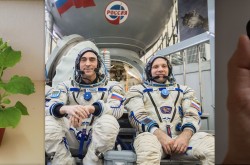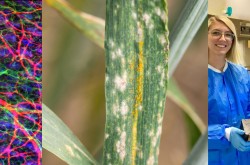3 things you should know — September edition


Meet Renée-Claude Goulet, Jesse Rogerson, and Michelle Campbell Mekarski.
These Ingenium employees are professional science communicators, and provide expert advice on key subjects relating to our three museums — the Canada Agriculture and Food Museum, the Canada Aviation and Space Museum, and the Canada Science and Technology Museum.
In this new monthly blog series, Ingenium’s science communicators offer up three quirky nuggets related to their areas of expertise. For the September edition, they tackled regenerative agriculture, using sunlight to explore the depths of space, and the implications of microplastics in, well, pretty much everything

LightSail2’s on-board camera captures the fully extended solar sail and Earth below. Image taken 23 July 2019 at 11:48 PDT. Baja California and Mexico are visible.
Harnessing the power of the Sun for space exploration
The power of the Sun may be all we need to take us sailing into the future of space exploration.
Last June, the LightSail2 spacecraft successfully launched into low earth orbit (LEO)* by the Planetary Society — a non-governmental, non-profit foundation which promotes space exploration. Its mission: to investigate the use of solar sails as a means of propulsion in outer space.
Currently, when maneuvering a spacecraft that is already in outer space, we use chemical rockets; we ignite a flammable substance and control the flow of the fire in the opposite direction from travel, which propels the spacecraft forward (otherwise known as a rocket). But there are some large downsides to conventional rockets, and there might be other ways to do this.
Solar sailing exploits the fact that sunlight carries momentum; when sunlight hits something, it actually pushes on it a little bit. A very little bit — obviously the sunlight hitting you doesn’t have enough momentum to knock you off your feet! But in space, the momentum of light can be used to our advantage. A solar sail spacecraft, like a sailboat, uses a large piece of material to catch sunlight and accelerate.
The viability of this has already been tested: the Japanese spacecraft IKAROS was launched in 2010, unfurled a large sail 40 m by 40 m in size (about the size of two tennis courts), and successfully measured an acceleration due to sunlight.
The Planetary Society’s LightSail2 is the next step in demonstrating the technological feasibility of solar sailing. When it first got to space, it was in a circular orbit around the Earth at a height of about 720 km. Over the next year, the solar sail will be used to change that orbit to an ellipse, such that its farthest distance will be much larger than 1,000 km, and its shortest distance will dip down into the atmosphere of Earth, at which point it will burn up.
Why a solar sail? The bonus of riding the light of the Sun is that its free! Plus, you don’t have to carry with you all the fuel you need to get where you want to go. With technology like this, we could send probes on much longer missions — to much further places — all with no need to send fuel.
If you want to follow the LightSail2 mission, check out their Mission Control page.
* LEO is defined as 100 < height < 2,000 km
By Jesse Rogerson

Plastic, plastic everywhere…even in my drink!
Plastic is a serious business in our society. We rely on plastic to drive cars, communicate, write grocery lists, clean the bathroom, and watch a movie. With good reason: it’s light, strong, durable, cheap to make, and can be molded, cast, blown, and woven into almost any shape and texture. The problem comes when we’re done with the plastic products we use. Plastic can be broken into smaller and smaller pieces, but it never truly goes away. Instead, we’re left with teeny-tiny fragments called “microplastics.”
Increasingly, the media has been reporting the effects microplastics have on ocean life. To many marine animals, the floating fragments look like food. So, indigestible plastic ends up in the stomachs of birds, whales, fish, and baby dugongs, where it can result in internal injuries, blockages, and death.
We’re quickly realizing that the risk isn’t limited to sea life. Plastic particles can be transported by air, falling on snow, soil, and freshwater systems. The net result? According to a new report by the World Wild Fund for Nature, plastic is “contaminating the air we breathe, the food we eat, and the water drink”. In fact, the average person could be ingesting five grams per week (that’s equivalent to a credit card!).
Perhaps even more alarming is the fact that we don’t really understand what all this plastic is doing to us. While the negative effects of plastic on animal life is well documented, the impact for humans is less clear. Regardless, we know enough to say that eating and breathing plastic probably isn’t good for our health.
Perhaps the shock of finding plastic in our food and drink will provide motivation to change the way we use plastic on a day to day basis. After all, plastic is not the enemy – used correctly, it can help the environment. Plastic products often take less energy to make and transport. Plastics are used to make solar panels, lighter cars, and energy efficient homes. Plastics can also prevent food waste.
The solution is to prevent plastic waste from polluting the environment in the first place. Improved waste management and recycling, better product design that curtails disposable packaging, and reduction in unnecessary single-use plastics all have a role to play in diverting billions of pounds of plastic waste annually. When it comes to plastic, we don’t have to do without, but we certainly have to do differently.
Visit the Green Education Foundation for tips on how to use less plastic.
By Michelle Campbell Mekarski

A row of young soybean plants growing between rows of yellowing ryegrass cover crop.
Rebuilding soils with regenerative agriculture
Regenerative agriculture is all about rebuilding soil — our most important and threatened agricultural resource — and the ecosystem that surrounds it. This approach is steadily gaining momentum across Canada, from small, diversified operations to large, cash crop farms.
The practise of regenerative agriculture focuses on sequestering carbon in the soil, reducing its physical disturbances, and nurturing the underground food web, which plays a vital role in soil’s functioning and in plant growth. There is no certifying body for regenerative agricultural practises like there is for organic production. They can therefore be applied by any farmer, to any degree of intensity, regardless of the chosen production system. Let’s look at a few methodologies that are garnering interest from Canadian farmers.
Rotational grazing is the practise of putting animals on the land in small pens, which are moved every day. This allows animals to fertilize fields with their manure as they graze. The carbon contained in the manure feeds soil organisms, and is ultimately stored underground. Bacteria in the soil convert nutrients from the animals’ waste into forms plants can take up, thereby reducing the amount of fertilizer required for a crop that’s planted in the same field.
Another tenet of regenerative agriculture is to introduce more diversity through the use of cover crops — smaller plants growing under the main crop — which keep the soil covered and stabilized. Usually present in the mix are legumes, those plants whose roots extract nitrogen from the atmosphere with the help of symbiotic microbes. Fixated nitrogen then remains in the soil, available for the next crop after the plant dies.
Ditching the plough is an additional soil-friendly practise. Ploughing is traditionally used to control weeds in the field, to incorporate crop residues into the soil after a growing season, and to break up heavy soil in spring before planting. However, research shows that this disturbance is catastrophic for both soil life and soil structure, contributes immensely to erosion, and even releases greenhouse gases. Instead, farmers who do no-till (no plough) agriculture plant directly in the stubble of the previous year’s crops, and rely on other methods to control weeds — leaving the soil sealed.
In a nutshell, regenerative agriculture provides tools for farmers to improve soil resources on their farms, reduce the amount of inputs they require to grow crops and raise livestock, and build healthier, more resilient farm systems. Increasingly, farmers are seeing the benefits of putting biology first on their farms, and it won’t be long until these forward-thinking practises replace the old ways, all across the country.
By Renée-Claude Goulet
















